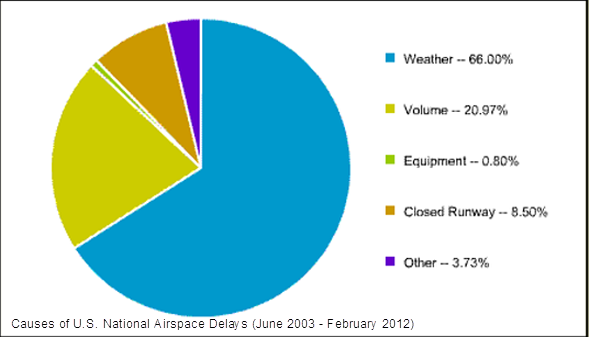2.4 NAS Impacts
Weather has always been a major constraint to air transportation but its impact has grown in recent years largely due to increased enroute traffic volumes and growing enroute congestion.
 The National Airspace System (NAS) of the United States is one of the most efficient in the world because it is allowed to operate at full capacity until weather or other constraints require the implementation of traffic management procedures to help minimize aircraft congestion particularly over highly traveled routes and airports. The higher volumes of enroute traffic result in much more difficult air traffic management decision making than those in response to terminal impacts or other constraints.
The National Airspace System (NAS) of the United States is one of the most efficient in the world because it is allowed to operate at full capacity until weather or other constraints require the implementation of traffic management procedures to help minimize aircraft congestion particularly over highly traveled routes and airports. The higher volumes of enroute traffic result in much more difficult air traffic management decision making than those in response to terminal impacts or other constraints.
Factors which impact whether a flight can depart for their destination include:
- Aviation forecasts
- Departing and Destination meteorological observations
- Air traffic over the NAS.
If weather conditions are near important thresholds for operations, a variation of only one hundred feet in a forecast cloud height or one quarter mile in forecast visibility can determine whether an aircraft is allowed to depart or whether additional fuel must be carried onboard to reach a specified alternate airport.
According to the Department of Transportation (DOT) statistics, weather is the cause of approximately 60 percent of the delays in the National Airspace System (NAS). When weather adversely impacts landing operations at one of the hundreds of airports in the United States, it often causes delays and congestion at other airports. Ground delays, "stacking up" of planes circling and waiting to land, and/or diversion of incoming flights to other "alternate" airports can all add tremendous expense and long delays in travel schedules. This adds stress on the air traffic management system responsible for maintaining a safe, smooth, and timely flow of aircraft between destinations.
The graphic below shows the leading causes for NAS delays. Weather is the leading cause.

(Source: Department of Transportation, Research and Innovative Technology Administration, Bureau of Transportation Statistics
Available at: http://www.transtats.bts.gov/OT_Delay/OT_DelayCause1.asp

